A Convenient Diels-Alder Approach toward Potential Polyketide-like Antibiotics Using α-Activated α,β-Unsaturated 4,4-Dimethyl-1-tetralones as Dienophiles
Abstract
1. Introduction
2. Results and Discussion
3. Experimental Section
3.1. Materials and Reagents
3.2. General Procedure for Preparation of Dienophiles 2–9 Using 6 as a Typical Example
3.2.1. Methyl 6-Chloro-4,4-dimethyl-1-oxo-1,4-dihydronaphthalene-2-carboxylate (6)
3.2.2. Methyl 5-Methoxy-4,4-dimethyl-1-oxo-1,4-dihydronaphthalene-2-carboxylate (3)
3.2.3. Methyl 7-Methoxy-4,4-dimethyl-1-oxo-1,4-dihydronaphthalene-2-carboxylate (5)
3.2.4. Methyl 4,4-Dimethyl-7-oxo-4,7-dihydrobenzo[b]thiophene-6-carboxylate (8)
3.3. General Procedure for Preparation of Diels-Alder Adducts 10–28 Using 10 as a Typical Example
3.3.1. (4aS,9aR)-Methyl 2,3,9,9-Tetramethyl-10-oxo-1,4,4a,9,9a,10-hexahydroanthracene-4a-carboxylate (10)
3.3.2. (4aS,9aR)-Methyl 8-Methoxy-2,3,9,9-tetramethyl-10-oxo-1,4,4a,9,9a,10-hexahydroanthracene-4a-carboxylate (11)
3.3.3. (4aS,9aR)-Methyl 7-Methoxy-2,3,9,9-Tetramethyl-10-Oxo-1,4,4a,9,9a,10-Hexahydroanthracene-4a-Carboxylate (12)
3.3.4. (4aS,9aR)-Methyl 6-Methoxy-2,3,9,9-tetramethyl-10-oxo-1,4,4a,9,9a,10-hexahydroanthracene-4a-carboxylate (13)
3.3.5. (4aS,9aR)-Methyl 7-Chloro-2,3,9,9-tetramethyl-10-oxo-1,4,4a,9,9a,10-hexahydroanthracene-4a-carboxylate (14)
3.3.6. (4aS,9aR)-Methyl 5,7-Dimethoxy-2,3,9,9-tetramethyl-10-oxo-1,4,4a,9,9a,10-hexahydroanthracene-4a-carboxylate (15)
3.3.7. (4aR,8aS)-Methyl 4,4,6,7-Tetramethyl-9-oxo-4,4a,5,8,8a,9-hexahydronaphtho[2,3-b]thiophene-8a-carboxylate (16)
3.3.8. (4aS,9aR)-Methyl 2,9,9-Trimethyl-10-oxo-1,4,4a,9,9a,10-hexahydroanthracene-4a-carboxylate (17)
3.3.9. (4aS,9aR)-Methyl 7-Methoxy-2,9,9-trimethyl-10-oxo-1,4,4a,9,9a,10-hexahydroanthracene-4a-carboxylate (18)
3.3.10. (4aS,9aR)-Methyl 7-Chloro-2,9,9-trimethyl-10-oxo-1,4,4a,9,9a,10-hexahydroanthracene-4a-carboxylate (19)
3.3.11. (4R,4aS,9aR)-Methyl 4,9,9-Trimethyl-10-oxo-1,4,4a,9,9a,10-hexahydroanthracene-4a-carboxylate (20)
3.3.12. (4R,4aS,9aR)-Methyl 7-Methoxy-4,9,9-trimethyl-10-oxo-1,4,4a,9,9a,10-hexahydroanthracene-4a-carboxylate (21)
3.3.13. (4R,4aS,9aR)-Methyl 7-Chloro-4,9,9-trimethyl-10-oxo-1,4,4a,9,9a,10-hexahydroanthracene-4a-carboxylate (22)
3.3.14. (5aS,11aR)-Methyl 11,11-Dimethyl-6-oxo-1,4,5,5a,6,11,11a,12-octahydrotetracene-5a-carboxylate (23)
3.3.15. (5aS,11aR)-Methyl 9-Methoxy-11,11-dimethyl-6-oxo-1,4,5,5a,6,11,11a,12-octahydrotetracene-5a-carboxylate (24)
3.3.16. (5aS,11aR)-Methyl 9-Chloro-11,11-dimethyl-6-oxo-1,4,5,5a,6,11,11a,12-octahydrotetracene-5a-carboxylate (25)
3.3.17. (4aR,10aS)-Methyl 4,4-Dimethyl-11-oxo-4,4a,5,6,9,10,10a,11-octahydroanthra[2,3-b]thiophene-10a-carboxylate (26)
3.3.18. (4aS,9aR)-Methyl 9,9-Dimethyl-2,10-dioxo-1,2,4a,9,9a,10-hexahydroanthracene-4a-carboxylate (27)
3.3.19. (4aR,8aS)-Methyl 4,4-Dimethyl-6,9-dioxo-4,4a,5,6,8a,9-hexahydronaphtho[2,3-b]thiophene-8a-carboxylate (28)
3.3.20. (2R,4aS,9aS)-2,3,9,9-Tetramethyl -2,3,9,9a-tetrahydro-1H-2,4a-methanoanthracene-4,10-dione (29)
4. Conclusions
Supplementary Materials
Author Contributions
Funding
Institutional Review Board Statement
Informed Consent Statement
Data Availability Statement
Conflicts of Interest
References and Notes
- Ueki, M.; Koshiro, N.; Aono, H.; Kawatani, M.; Uramoto, M.; Kawasaki, H.; Osada, H. Isolation of New Polyketide Metabolites, Linearolides A and B from Streptomyces sp. RK95-74. J. Antibiot. 2013, 66, 333–337. [Google Scholar] [CrossRef] [PubMed]
- Wang, Z.; Yang, G.-X.; Liu, C.; Wang, L.; Qi, Y.; Cao, M.; Guo, X.; Li, J.; Huang, X.; Zang, J.; et al. Isolation and Biosynthesis of Phenazine-Polyketide Hybrids from Streptomyces sp. KIB-H483. J. Nat. Prod. 2022, 85, 1324–1331. [Google Scholar] [CrossRef] [PubMed]
- Almalki, M.A. Isolation and Characterization of Polyketide Drug Molecule from Streptomyces Species with Antimicrobial Activity Against Clinical Pathogens. J. Infect. Public Health 2020, 13, 125–130. [Google Scholar] [CrossRef] [PubMed]
- Huang, J.-K.; Lauderdale, T.-L.Y.; Shia, K.-S. Studies on Antibiotics Active Against Resistant Bacteria. Total Synthesis of MRSA-Active Tetarimycin A and its Analogues. Org. Lett. 2015, 17, 4248–4251. [Google Scholar] [CrossRef]
- Huang, J.-K.; Lauderdale, T.-L.Y.; Shia, K.-S. Total Synthesis of Tetarimycin A, (±)-Napthacemycin A9, and (±)-Fasamyc.in A: Structure-Activity Relationship Studies Against Drug-Resistant Bacteria. J. Org. Chem. 2018, 83, 6508–6523. [Google Scholar] [CrossRef]
- Huang, J.-K.; Shia, K.-S. Development of a Cross-Conjugated Vinylogous [4 + 2] Anionic Annulation and Application to the Total Synthesis of Natural Antibiotics (±)-ABX. Angew. Chem. Int. Ed. 2020, 59, 6540–6545. [Google Scholar] [CrossRef]
- Qin, Z.; Munnoch, J.T.; Devine, R.; Holmes, N.A.; Seipke, R.F.; Wilkinson, K.A.; Wilkinson, B.; Hutchings, M.I. Formicamycins, Antibacterial Polyketides Produced by Streptomyces Formicae Isolated from African Tetraponera Plant-Ants. Chem. Sci. 2017, 8, 3218. [Google Scholar] [CrossRef]
- Fukumoto, A.; Kim, Y.-P.; Iwatsuki, M.; Hirose, T.; Sunazuka, T.; Hanaki, H.; Ōmura, S.; Shiomi, K. Naphthacemycins, Novel Circumventors of β-Lactam Resistance in MRSA, Produced by Streptomyces sp. KB-3346-5. II. Structure Elucidation. J. Antibiot. 2017, 70, 568–573. [Google Scholar] [CrossRef]
- Kallitidas, D.; Kang, H.-S.; Brady, S.F. Tetarimycin A, an MRSA-Active Antibiotic Identified Through Induced Expression of Environmental DNA Gene Clusters. J. Am. Chem. Soc. 2012, 134, 19552–19555. [Google Scholar] [CrossRef]
- Kim, H.; Lantvit, D.; Hwang, C.H.; Kroll, D.J.; Swanson, S.M.; Franzblau, S.G.; Orjala, J. Indole Alkaloids from Two Cultured Cyanobacteria, Westiellopsis sp. and Fischerella Muscicola. Bioorg. Med. Chem. 2012, 20, 5290–5295. [Google Scholar] [CrossRef]
- Zhang, Y.; Yin, Z.; Wu, X.-F. Iron-Catalyzed Synthesis of Dihydronaphthalenones from Aromatic Oxime Esters. Adv. Synth. Catal. 2019, 361, 3223–3227. [Google Scholar] [CrossRef]
- Wu, Y.-K.; Ly, T.W.; Shia, K.-S. α-Activated Cross Conjugated Cycloalkenone Systems in Organic Synthesis. In Advances in Organic Synthesis; Atta-ur-Rahman, Ed.; Bentham Science Publishers: Hilversum, The Netherlands, 2012; Volume 5, pp. 216–259. [Google Scholar]
- Fringuelli, F.; Taticchi, A.; Wenkert, E. Diels-Alder Reactions of Cycloalkenones in Organic Synthesis. Org. Prep. Proc. Int. 1990, 22, 133–165. [Google Scholar] [CrossRef]
- Liu, H.J.; Browne, E.N.C. 2-Carbomethoxy-4,4-dimethyl-2,5-cyclohexadien-1-one as a Dienophile. A Convenient Approach to the 4,4-Dimethyl-1-decalone System. Tetrahedron Lett. 1977, 18, 2919–2922. [Google Scholar] [CrossRef]
- Liu, H.J.; Browne, E.N.C. Diels–Alder Reactions of 4,4-Dimethyl-2-cyclohexenones. A Direct Route to the 4,4-Dimethyl-1-decalones. Can. J. Chem. 1987, 65, 1262–1278. [Google Scholar] [CrossRef]
- Fringuelli, F.; Pizzo, F.; Taticchi, A.; Halls, T.D.J.; Wenkert, E. Diels-Alder Reactions of Cycloalkenones. 1. Preparation and Structure of the Adducts. J. Org. Chem. 1982, 47, 5056–5065. [Google Scholar] [CrossRef]
- Fringuelli, F.; Minuti, L.; Pizzo, F.; Taticchi, A.; Halls, T.D.J.; Wenkert, E. Diels-Alder Reactions of Cycloalkenones. 2. Preparation and Structure of Cyclohexadienone Adducts. J. Org. Chem. 1983, 48, 1810–1813. [Google Scholar] [CrossRef]
- Liu, H.J.; Ngooi, T.K.; Browne, E.N.C. Diels–Alder Reactions of 2-Carbomethoxy-2-cyclohexen-1-one. Can. J. Chem. 1988, 66, 3143–3152. [Google Scholar] [CrossRef]
- Liotta, D.; Saindane, M.; Barnum, C. Diels-Alder Reactions Involving Cross-Conjugated Dienones. Effects of Substitution on Reactivity. J. Am. Chem. Soc. 1981, 103, 3224–3226. [Google Scholar] [CrossRef]
- Liu, H.J.; Han, Y. Facial Selectivity in Diels-Alder Reaction of 4,4-Disubstituted 2,5-Cyclohexadienones. Tetrahedron Lett. 1993, 34, 423–426. [Google Scholar]
- Crystallographic Data for CCDC 1838083 (d19262) also lend support to the structural elucidation of the Diels-Alder product (17): C19H22O3, Mw = 298.37, cell, a = 8.6866(11) Å, b = 9.0657(12) Å, c = 10.9733(14) Å, α = 77.551(4) Å, β = 75.651(4) Å, γ = 68.105(4) Å, V = 769.48(17) Å, space group P -1, Z = 2, Nref 2742 were independent; for the observed data, wR2 = 0.1070(2721), R = 0.0417(2113).
- Crystallographic Data for CCDC 1838080 (d18814) (20): C19H22O3, Mw = 298.37, cell, a = 8.2078(3) Å, b = 9.5084(4) Å, c = 11.3548(5) Å, α = 68.335(1) Å, β = 77.530(1) Å, γ = 69.151(1) Å, V = 765.98(5) Å, space group P -1, Z = 2, Nref 2710 were independent; for the observed data, wR2 = 0.1055(2683), R = 0.0379(2365).
- Crystallographic Data for CCDC 1838081 (d18985) (21): C20H24O4, Mw = 328.39, cell, a = 8.5236(4) Å, b = 9.9115(5) Å, c = 10.9382(5) Å, α = 65.938(1) Å, β = 81.411(1) Å, γ = 83.286(1) Å, V = 832.71(7) Å, space group P -1, Z = 2, Nref 2971 were independent; for the observed data, wR2 = 0.0867(2896), R = 0.0349(2582).
- Crystallographic Data for CCDC 1838082 (d18986) (22): C19H21ClO3, Mw = 332.81, cell, a = 8.2565(4) Å, b = 9.8020(6) Å, c = 11.5948(7) Å, α = 65.106(2) Å, β = 78.505(2) Å, γ = 75.694(2) Å, V = 819.93(8) Å, space group P -1, Z = 2, Nref 2971 were independent; for the observed data, wR2 = 0.0795(2873), R = 0.0308(2577).
- Huang, J.-K.; Shia, K.-S. Anionic Diels−Alder Chemistry of Cyclic Sodium Dien-1-olates Delivering Highly Stereoselective and Functionalized Polycyclic Adducts. Org. Lett. 2021, 23, 5709–5713. [Google Scholar] [CrossRef]
- Crystallographic Data for CCDC 2204212 (d22314) (29): C19H22O2, Mw = 282.37, cell, a = 11.8648(5) Å, b = 10.5302(5) Å, c = 12.4692(6) Å, α = 90 Å, β = 94.065(1) Å, γ = 90 Å, V = 832.71(7) Å, space group P 21/n, Z = 4, Nref 2752 were independent; for the observed data, wR2 = 0.1184(2739), R = 0.0427(2222).
- Liang, D.; Zou, Y.; Wang, Q.; Goeke, A. Sequential Diels-Alder Reaction/Rearrangement Sequence: Synthesis of Functionalized Bicyclo[2.2.1]heptane Derivatives and Revision of Their Relative Configuration. J. Org. Chem. 2014, 79, 6726–6731. [Google Scholar] [CrossRef] [PubMed]

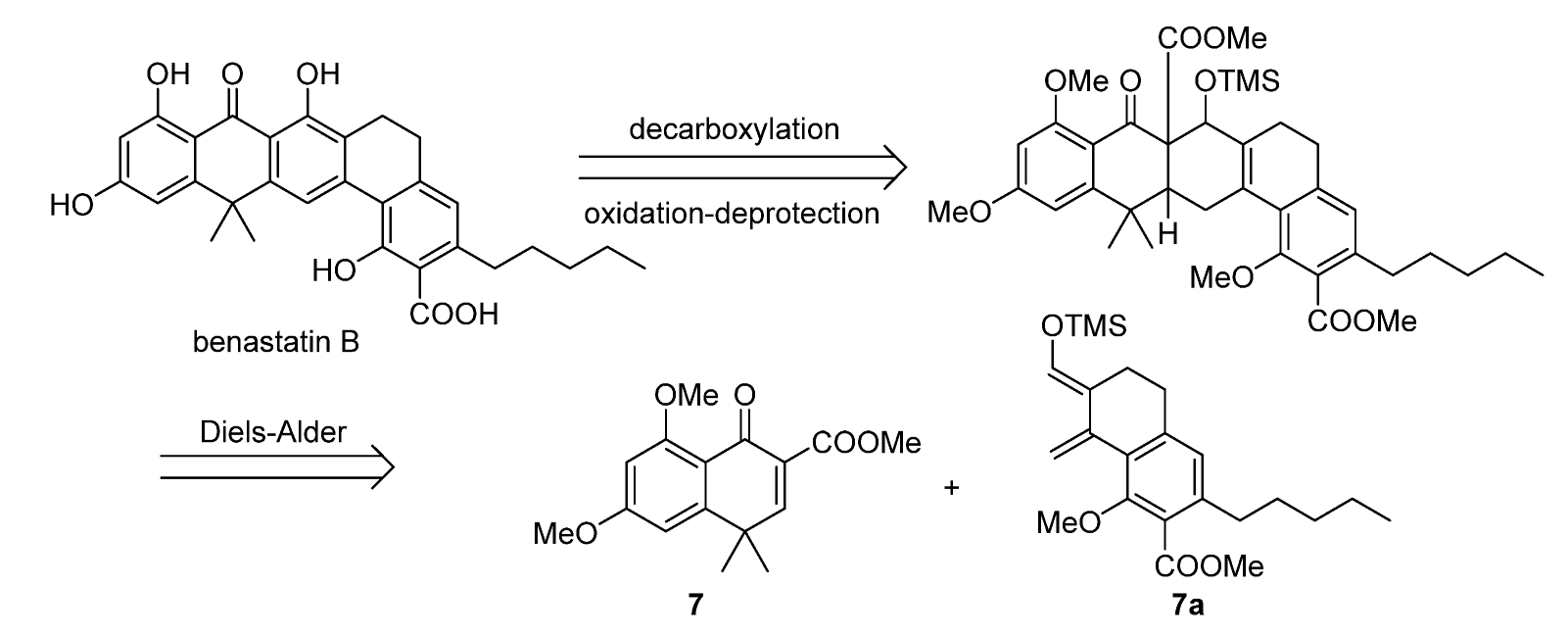
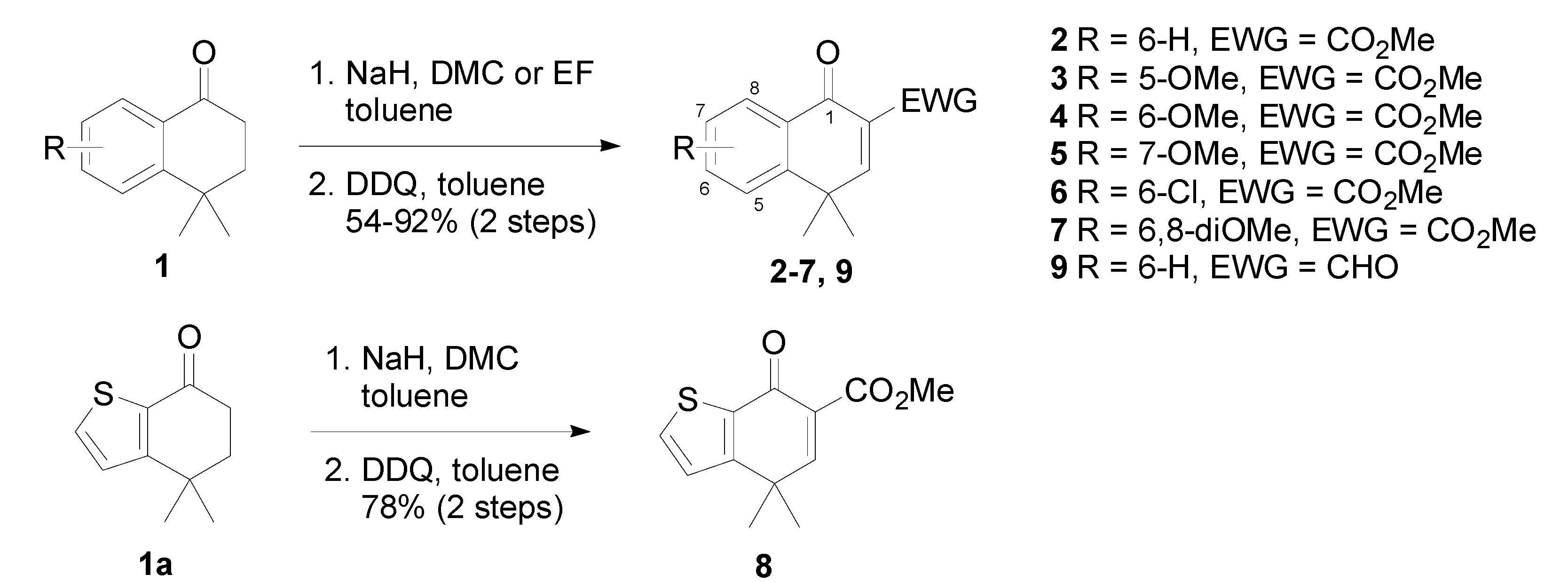

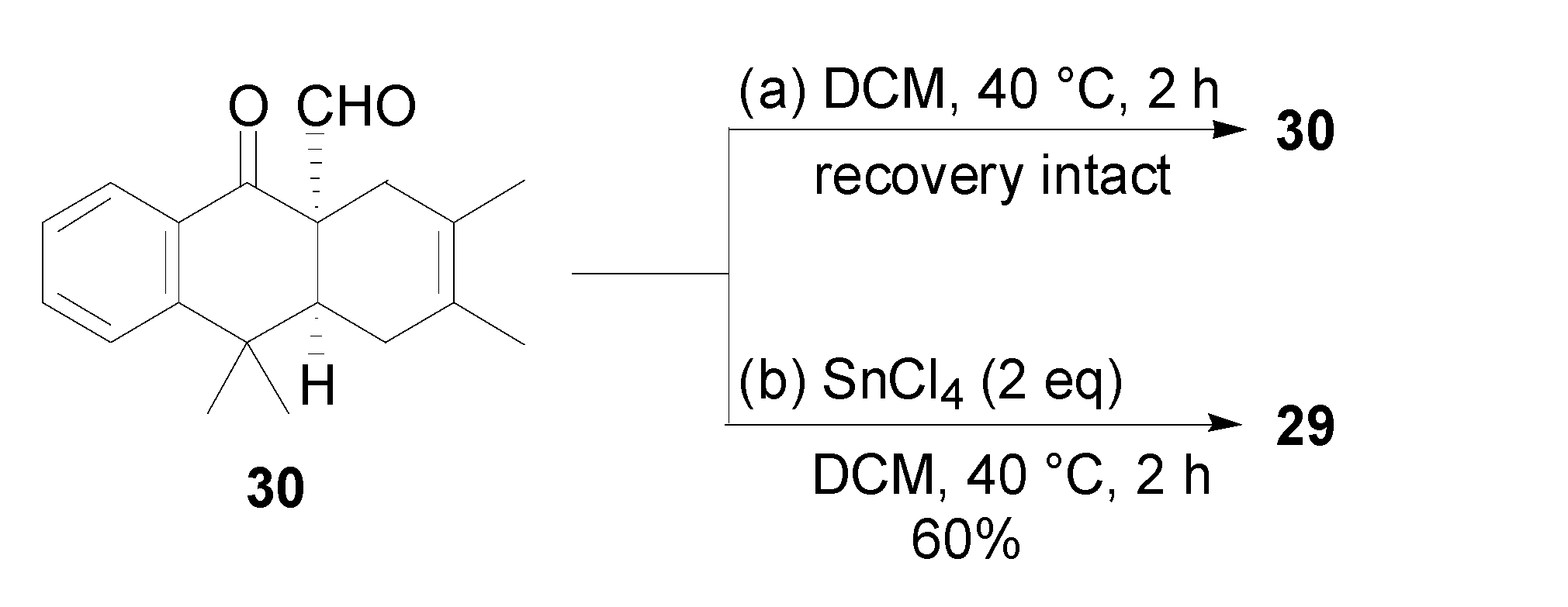

 | ||||
|---|---|---|---|---|
| Entry | Diene (equiv.) | SnCl4 (equiv.) | Time (h) | Yield (%) b |
| 1 | 20 | 2.5 | 3 | 84 |
| 2 | 10 | 2 | 5 | 91 |
| 3 c | 10 | 2 | 2.5 | 98 |
| 4 c | 5 | 2 | 3 | 93 |
| 5 c | 2 | 2 | 5 | 71 |
 | |||||
|---|---|---|---|---|---|
| Entry | Dienophile | Diene | t (h) | Product | Yield (%) b |
| 1 | 2 |  | 2.5 | 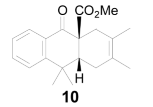 | 98 |
| 2 | 3 | ,, | 29 | 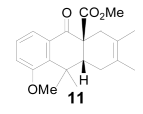 | 74 c |
| 3 | 4 | ,, | 18 | 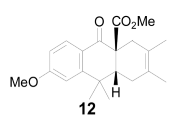 | 86 |
| 4 | 5 | ,, | 18 | 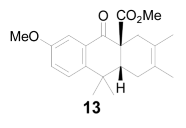 | 75 |
| 5 | 6 | ,, | 2 | 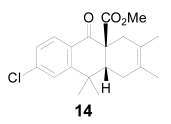 | 87 |
| 6 | 7 | ,, | 24 | 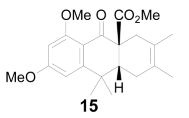 | 91 |
| 7 | 8 | ,, | 2 | 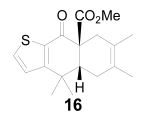 | 83 |
| 8 | 2 |  | 2 |  | 78 d |
| 9 | 4 | ,, | 16 | 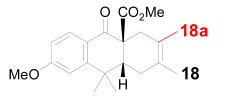 | 81 e |
| 10 | 6 | ,, | 1.5 | 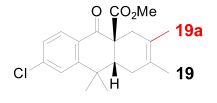 | 79 f |
| 11 | 2 |  | 2 | 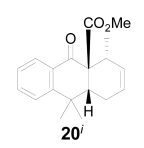 | 85 |
| 12 | 4 | ,, | 16 | 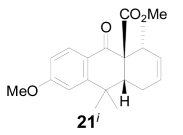 | 87 |
| 13 | 6 | ,, | 1.5 | 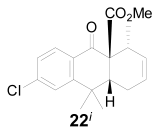 | 99 |
| 14 | 2 |  | 2 |  | 94 |
| 15 | 4 | ,, | 18 |  | 71 |
| 16 | 6 | ,, | 2.5 | 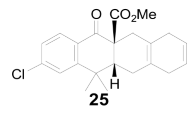 | 76 |
| 17 | 8 | ,, | 2.5 | 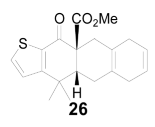 | 99 |
| 18 | 2 |  | 15 |  | 63 g,h |
| 19 | 8 | ,, | 18 | 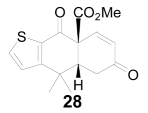 | 72 g,h |
Disclaimer/Publisher’s Note: The statements, opinions and data contained in all publications are solely those of the individual author(s) and contributor(s) and not of MDPI and/or the editor(s). MDPI and/or the editor(s) disclaim responsibility for any injury to people or property resulting from any ideas, methods, instructions or products referred to in the content. |
© 2023 by the authors. Licensee MDPI, Basel, Switzerland. This article is an open access article distributed under the terms and conditions of the Creative Commons Attribution (CC BY) license (https://creativecommons.org/licenses/by/4.0/).
Share and Cite
Lee, C.-J.; Ramasamy, M.; Kuan, H.-H.; Wu, C.-H.; Lee, C.-C.; Lee, J.-C.; Shia, K.-S. A Convenient Diels-Alder Approach toward Potential Polyketide-like Antibiotics Using α-Activated α,β-Unsaturated 4,4-Dimethyl-1-tetralones as Dienophiles. Molecules 2023, 28, 2739. https://doi.org/10.3390/molecules28062739
Lee C-J, Ramasamy M, Kuan H-H, Wu C-H, Lee C-C, Lee J-C, Shia K-S. A Convenient Diels-Alder Approach toward Potential Polyketide-like Antibiotics Using α-Activated α,β-Unsaturated 4,4-Dimethyl-1-tetralones as Dienophiles. Molecules. 2023; 28(6):2739. https://doi.org/10.3390/molecules28062739
Chicago/Turabian StyleLee, Chia-Jui, Manickavasakam Ramasamy, Hsuan-Hao Kuan, Chien-Huang Wu, Chein-Chung Lee, Jinq-Chyi Lee, and Kak-Shan Shia. 2023. "A Convenient Diels-Alder Approach toward Potential Polyketide-like Antibiotics Using α-Activated α,β-Unsaturated 4,4-Dimethyl-1-tetralones as Dienophiles" Molecules 28, no. 6: 2739. https://doi.org/10.3390/molecules28062739
APA StyleLee, C.-J., Ramasamy, M., Kuan, H.-H., Wu, C.-H., Lee, C.-C., Lee, J.-C., & Shia, K.-S. (2023). A Convenient Diels-Alder Approach toward Potential Polyketide-like Antibiotics Using α-Activated α,β-Unsaturated 4,4-Dimethyl-1-tetralones as Dienophiles. Molecules, 28(6), 2739. https://doi.org/10.3390/molecules28062739






